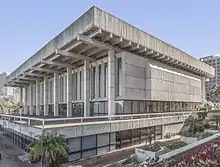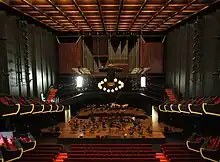Perth Concert Hall (Western Australia)
The Perth Concert Hall is a concert hall located in Perth, the capital of the Australian state of Western Australia. Owned by the City of Perth, the hall is the main venue of the West Australian Symphony Orchestra, and also hosts a number of other events and performances. The building itself is located in Perth's central business district, adjacent to the Supreme Court Gardens and Government House. The building has two façades: facing north over St Georges Terrace, and facing south over the Swan River.
| Perth Concert Hall | |
|---|---|
 | |
| General information | |
| Type | Concert hall |
| Architectural style | Brutalist |
| Town or city | Perth, Western Australia |
| Country | Australia |
| Coordinates | 31°57′29″S 115°51′50″E |
| Current tenants | West Australian Symphony Orchestra Various other events and performances |
| Construction started | 1971 |
| Opened | 26 January 1973 |
| Cost | A$3,201,873 (1973), equivalent to ~A$29 million in 2016[1] |
| Owner | City of Perth |
| Design and construction | |
| Architecture firm | Howlett and Bailey Architects |
| Other information | |
| Seating capacity | 1,729 people (main auditorium) |
| Website | |
| www | |
| Type | State Registered Place |
| Designated | 12 July 2002 |
| Reference no. | 4571 |
The concert hall was constructed on land granted to the City of Perth by the Government of Western Australia, and opened on Australia Day (26 January), 1973. Designed by Howlett and Bailey Architects, local architectural firm, the building is constructed in the Brutalist style, making heavy use of white off-form concrete and a solid opaque interior. The main auditorium of the hall seats 1,729 people, as well as a 160-person choir gallery and a 3000-pipe organ. Acoustically, the venue is considered one of the best in Australia, with the design overseen by the New Zealand acoustician Sir Harold Marshall.
History

In 1950, the Government of Western Australia granted the City of Perth land between Stirling Gardens and Government House. Howlett & Bailey designed an administrative building and an auditorium, however due to financial constraints, only the former was built, Council House opening in 1963. In 1968 Howlett & Bailey was appointed to design a concert hall with construction commencing in 1971.[2][3] It was officially opened on 26 January 1973 by the Governor General Paul Hasluck, with Prime Minister Gough Whitlam also in attendance.[4][5]
In January 2015 the West Australian Symphony Orchestra become the venue manager of the hall, taking over from AEG Ogden that had managed it since March 1999.[6][7] In April 2018, the City of Perth approved a $1.4 million upgrade for the concert hall.[8]
A $52 million redevelopment of the concert hall was announced in 2020 as part of the Perth City Deal project, with the WA government contributing $36.4 million, the federal government contributing $12 million and the City of Perth contributing $4 million.[9] In March 2022, With Architecture Studio and Office for Metropolitan Architecture (OMA) were appointed lead architects for the redevelopment.[10] In March 2023, the WA government announced an additional $98 million towards the project, bringing the total funding to $150 million. The redevelopment is scheduled to be completed by the end of 2024.[11]
Architectural design



The building was designed by Howlett and Bailey Architects. Jeffrey Howlett and Don Bailey had won a design competition for a Town Hall and auditorium in 1961. Their design consisted of two buildings, one containing administrative offices and the other, oval in shape, comprising the "town hall" or auditorium. The administration offices, called Council House, were built, however financial constraints and doubts regarding the auditorium's acoustic properties meant that construction of the auditorium building was delayed. Its design was subsequently re-considered and it was not until the late-1960s that a different plan was approved. This plan was
...to accommodate not more than 2,000 people and to cost no more than $2,000,000 and with the highest priority to be given to its musical uses, i.e. Symphony concerts, choral concerts, organ recitals, etc., and, in addition, performances of minimum staged ballet, fold dances or musical drama, and also be suitable for other functions such as large Civic receptions, conferences, conventions, public meetings, pageants, school speech days, pop concerts and folk singers.

Through 1969, the architectural plans were amended several times. These amendments included beautification and landscaping of the main pedestrian approach from St Georges Terrace and construction of a subway under the Terrace, a pit for a 60-piece orchestra with removable flooring and seating to cover the pit when not in use, and improved access and facilities for disabled people. The original plans included a restaurant with a seating capacity for 400, but following inspection of similar halls in the eastern states of Australia, it was decided that this was not warranted. It was, therefore, decided to make the restaurant smaller and include a tavern and cocktail bar, allowing patrons a wider choice. The bar area was named The Wardle Room, after Sir Thomas Wardle.
It was the architects' intention that the exhibition foyers would be used as a continually changing venue for all types of art (such as painting, tapestry and sculpture exhibitions) rather than as permanent exhibition spaces. This may have influenced the Perth City Council's indecision over whether or not to accept artist Sidney Nolan's offer to permanently loan the city a series of 64 paintings of wildflowers for hanging in the Hall. After considerable public debate over the matter, Nolan withdrew the offer and art dealers and others criticised the short sighted and parochial attitude of the Council in refusing the offer. Ironically, the first exhibition in the foyers featured 54 of Sidney Nolan's wildflower paintings.
Several consultants were involved in the design of the building, including acoustic consultants, structural engineers, and experts in escalators, stage machinery and lighting. D. H. Fraser was responsible for the structural design and Professor A. Harold Marshall was the acoustics consultant, in association with Warwick Mehaffey of the ABC.
Dr Marshall used computer modelling to predict how well people would hear in each of the seats and worked closely with the architects in designing the main auditorium, which according to Jefferey Howlett had to be:
"...a Great Room, as the Concertgebouw hall in Amsterdam, the Boston Symphony Hall and the Musikvereinsaal in Vienna are great rooms, recognised for their superb acoustic and that is not merely clarity...The great halls have ornate ceilings and other ornamentation. Though the Perth Concert Hall will be a completely modern building, the "fruity" ceilings and decorations of the older halls, which undoubtedly play a part in their acoustics, will be reproduced, in effect, in coffers hanging from the ceiling, in corrugated walls and in the complex double tier of boxes sloping up the side walls."
The Perth Concert Hall is an example of brutalist architecture, with its solid opaque interior, giant projecting roof, and use of white off-form concrete. It forms a counterpoint to the transparent filigree of Council House.[12]
The auditorium features a specially commissioned 3000-pipe organ surrounded by a 160-person choir gallery and an audience seating capacity of 1,729.[13] The organ, individually designed, cost $100,000 and was commissioned by Ronald Sharp of Sydney, who was also responsible for the organ at the Sydney Opera House. The larger pipes for the organ were imported from the Netherlands. Don Bailey recollects that Ron Sharp was an "extraordinarily talented person, largely self-educated, who has to his credit the design and construction of a number of organs, mostly in New South Wales. A nine-foot Steinway orchestral concert grand piano (Model D) was also imported from West Germany for installation in the Hall.
The Concert Hall was the first in Australia to have a show relay installed so that latecomers could watch on two screens in the foyer while waiting for an appropriate time to enter. Another screen is located at Stage Door.
The Perth City Council and State Government, as well as the architects and builders, received many compliments on the Hall as it neared completion from visiting experts in the fields of music, architecture and construction.
Operations
The Perth Concert Hall has been described as one of the best fine music acoustics venues in Australia.[13] It has played host to a diverse selection of internationally acclaimed performers including the London Philharmonic, Chicago Symphony, Israel Philharmonic and contemporary performers B.B. King, Sting, k.d. lang, Harry Connick Jr., Melissa Etheridge, Ray Charles, Rowan Atkinson and Billy Connolly.[13]
The majority of concerts by the West Australian Symphony Orchestra are performed at the Perth Concert Hall. The venue is also used for their rehearsals.
The venue is also used to host national conventions and exhibitions, award ceremonies and gala dinners. Recent exhibitions include the Steinway piano exhibition in March 2008. In addition, the venue is used for private or corporate functions in areas other than the auditorium, for example in the foyers, bar and café.
Association with Perth Concert Hall, Scotland
On 27 September 2006 the Perth Concert Hall participated in a twinning ceremony and the signing of Mutual Understanding with the Perth Concert Hall, Scotland. As a result of this twinning the Concert Hall now flies the St Andrews Flag at the front of the venue to commemorate the twinning.
Gallery
See also
References
- "Inflation Calculator". RBA. 14 February 1966. Retrieved 10 March 2017.
- Perth Concert Hall Heritage Perth
- Perth Concert Hall - A History West Australian Symphony Orchestra
- Vice Regal Canberra Times 27 January 1973 page 2
- Perth Concert Hall Architecture Australia December 1973 page 88
- "Perth Concert Hall : News". Perth Concert Hall. Retrieved 30 October 2017.
- Change in venue management Department of Culture & the Arts
- "Brutalist Perth concert hall to get upgrade". ArchitectureAU. 4 April 2018. Retrieved 11 March 2023.
- "Concert Hall gets $52m tizz". Perth Voice Interactive. 17 March 2022. Retrieved 11 March 2023.
- "Architects chosen for Perth Concert Hall redevelopment". ArchitectureAU. 11 March 2022. Retrieved 11 March 2023.
- Zimmerman, Josh (10 March 2023). "Huge cash injection for dilapidated Perth venue announced". The West Australian. Retrieved 11 March 2023.
- AA – Obituary – March/April 2006 Archived 31 July 2008 at the Wayback Machine
- Perth Concert Hall Web Site Archived 1 August 2001 at the Wayback Machine
Further reading
- Gregory, Jenny (2003) City of light : a history of Perth since the 1950s Perth, W.A. : City of Perth. ISBN 0-9594632-4-0 (pbk.) pp. 172–8.



